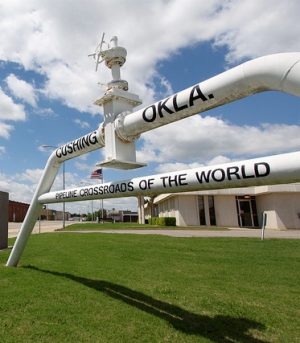
‘Substantial damage’ as magnitude 5.0 quake rattles Oklahoma oil hub
by Justin Juozapavicius, The Associated Press

40 to 50 buildings damaged, but one of world's largest oil storage terminals escapes unscathed; seismic activity has exploded in state recently due to underground injection of oil and gas industry wastewater

Cushing, Okla. is a major oil and gas industry crossroads and houses one of the largest oil storage terminals in the world. PHOTO: Roy Luck, via Flickr
CUSHING, Okla.—A magnitude 5.0 earthquake centred near one of the world’s key oil hubs brought down building facades and shattered windows, triggering fears the temblor may have damaged key infrastructure and rendered century-old buildings unsafe in the latest Oklahoma town rattled by increasingly strong quakes.
Cushing Assistant City Manager Jeremy Frazier told a news conference late Nov. 6 that a few minor injuries were reported. He said the damage appeared to be contained to downtown, where piles of debris sat at the base of some commercial buildings. An official confirmed Monday morning the city’s downtown sustained “substantial damage” and that 40 to 50 buildings were damaged.
Fearing aftershocks, police cordoned off older parts of the city to keep gawkers away. Frazier said an assisted living community had been evacuated after damage was reported. The Cushing Public School District cancelled Monday classes.
“Stay out of the area,” said City Manager Steve Spears, who noted that while some damage was superficial, compromised foundations and other potential problems would be difficult to assess until daylight in the city of 7,900 about 50 miles northeast of Oklahoma City.
City officials have scheduled a news conference Monday morning to discuss the quake’s impact.
The Oklahoma Department of Transportation reported Sunday night that no highway or bridge damage was found within a 15-mile radius of the earthquake’s epicenter.
The Oklahoma Corporation Commission said it and the Oklahoma Geological Survey were investigating after the quake, which struck at 7:44 p.m. Sunday and was felt as far away as Iowa, Illinois and Texas. The U.S. Geological Survey initially said Sunday’s quake was of magnitude 5.3 but later lowered the reading to 5.0.
Oklahoma has had thousands of earthquakes in recent years, with nearly all traced to the underground injection of wastewater left over from oil and gas production. Sunday’s quake was centred one mile west of Cushing—and about 25 miles south of where a magnitude 4.3 quake forced a shutdown of several wells last week.
“I thought my whole trailer was going to tip over, it was shaking it so bad,” said Cushing resident Cindy Roe, 50. “It was loud and all the lights went out and you could hear things falling on the ground.
“It was awful and I don’t want to have another one.”
Cushing’s oil storage terminal is one of the world’s largest. As of Oct. 28, tank farms in the countryside around Cushing held 58.5 million barrels of crude oil, according to data from the U.S. Energy Information Administration. The community bills itself as the “Pipeline Crossroads of the World.”
Frazier said two pipeline companies had reported no trouble as of late Sunday but that the community hadn’t heard from all companies.
According to USGS data, there have been 19 earthquakes in Oklahoma in the past week. When particularly strong quakes hit, the Oklahoma Corporation Commission directs well operators to seize wastewater injections or reduce volume.
A 5.8 earthquake—a record for Oklahoma—hit Pawnee on Sept. 3. Shortly afterward, geologists speculated on whether the temblor occurred on a previously unknown fault.
As of Monday morning, state regulators say normal operations have resumed at the Cushing oil storage terminal after the 5.0 magnitude quake.
Meanwhile, Oklahoma Corporation Commission spokesman Matt Skinner said state regulators are reviewing whether to shut down or restrict activity at some disposal wells, where wastewater from oil and gas production is injected.